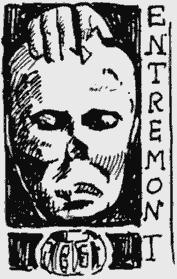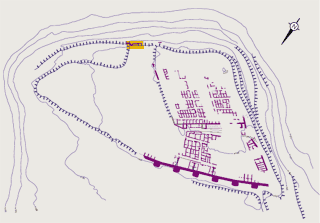- Home
- Research and interpretations
- Institutions and people
Plan, May 1946. Entremont field notebook, 1946, volume 1.
When in 1817, the prefect ordered that the first sculpted blocks from Entremont be transported to the Méjanes library, only the Ministry of the Interior had authority over the conservation of archaeological remains in France.
While Prosper Mérimée, general inspector of historic monuments in France, questioned the origins of the sculptures and the nature of the site in 1835, the evidence did not inspire him to worry about the future of the "wild entrenchment of Entremont."
For more than a century the fate of archaeology has been intimately connected with that of historic monuments. From the time of its creation within the Ministry of National Education, the Centre National de la Recherche Scientifique (CNRS) has lead the work of archaeology and historic monuments.
On July 13, 1943, the 15th commission of the CNRS (Archaeological excavations in metropolitan France) approved the listing of “the sculpture fragments discovered on the Antremont plateau and stocked at the Museum of Aix, as well as the property on which they were found” as a historic monument. Immediately after the war, the CNRS named persons such as Henri Rolland and Fernand Benoit, as directors of antiquities in Provence. Robert Ambard devoted his entire professional life to assisting Fernand Benoît with the excavations of Entremont, and he frequently called upon illustrators from the CNRS to draw plans or propose reconstructions.
After having declared the site as public, by the decree of July 28, 1950, the Ministry of National Education began acquiring the property, either by willing consent or by expropriation. This operation was completed on October 6, 1952. In 1949 a protocol was established between the Ministry of Education and the army. The former was responsible for the acquisition of the properties by the State, while the latter obtained exclusive use of them.
The institutions that currently participate in the study and conservation of moveable and immovable archaeological remains (archaeology, historic monuments, museums) have over the years become affiliated with the Ministry of the Interior (1837), the Ministry of National Education (1940), and the Ministry of the Culture (1959). Only the CNRS retains its affiliation with the Ministry of National Education or Research.
Motif on the cover of the Entremont field notebook of 1946, volume 1.
In 1994, the Direction of Antiquities (created in 1945) became the Services régionaux de l’Archéologie (Regional Archaeology Services). This new body united conservators and engineers responsible for the study, conservation, protection and promotion of archaeological heritage, as a sub-unit of the Regional Direction of Cultural Affairs. Archaeologists now have the task of managing the archaeological remains found during excavation, while the regional conservators of historic monuments are responsible for their conservation and valorization.
The "program" law concerning historic monuments (1988-1992) presented an opportunity to develop a program of restoration and adaptation of the whole site. The construction of parking lots for busses and cars, a route of trails over the site, the restoration of floors and streets and potential reconstructions were all manners of valorizing the site that could now be considered.
Excavations of 1992.
The postern was restored in 1992. In 1994 and 1995 the floors of a few huts and some streets were restored. The head architect of historic monuments, Didier Reppelin, installed hidden wells in the center of huts and at street corners. However, this installation proved to be insufficient during strong rains, which accumulated at the base of the oppidum by following slope of the urban topography. Recent excavations have now allowed the restoration of the drainage system.
The fate of the collections has followed that of the museums of Aix. First at the Méjanes library, then the city hall, the statuary was moved in 1828 to the priory garden of Malte, where its conservation was not well assured. During the 1960’s, M. Malbos, conservator of the museum, assured the presentation of the statuary under the control of the inspector of historic monuments. In 1987, the Granet museum, under the direction of Denis Coutagne, restored the galleries devoted to Entremont. A significant collective work on the collections resulted the publication of a book entitled "Archéologie d’Entremont au musée Granet"("The archaeology of Entremont at the Granet museum"). The museum is currently engaged in creating new presentations for the public.
Presentation of the statuary at the Musée Granet




